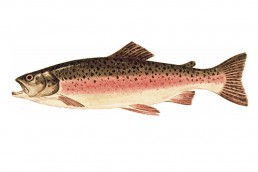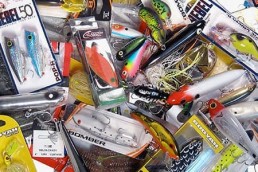Now’s the Time to Tackle Up for Trout Season
SHARE THIS POST
March is when many think about the tackle they’ll need to catch trout. Those whose passion is this species need to take an inventory and see if additions can be made to their overall tackle.
First, you need to decide what type of tackle you are using. Do you want to fly fish and go with a fly rod and fly tackle or stay with spinning tackle because you’re familiar with it? Actually, any type of tackle can be used to catch trout. In all my years on trout streams I have seen just about every kind of tackle. I’ve seen tag elder poles cut next to the stream being used (did it myself as a kid), cane poles, casting tackle, spin tackle and fly tackle. But spinning (or spincasting rods) and fly rods are the norm for trout.
For spinning equipment, I have two setups I use depending on the stream. For the smaller brushy streams, I have a 3 1/2- foot rod that I made and an ultra-light spincasting reel. Actually, I have two ultra-light reels, each with different test line. I switched from spinning to spincasting on the brushy streams because the line standing off of the spinning setup kept catching on the brush. Once that happened I switched to spincasting on all of my trout equipment, but that was a personal choice. For the larger streams, I use a 6-foot ultra-light rod with a spincasting reel. I also have a 5-foot ultra-light rod for certain special occasions. I use my spinning equipment for about the first month of the trout year and on some of the real small streams I fish. Spinning early around the month of May is done because the water is darker and usually high and the spinners work better than flies. My advice for those looking to get serious about trout fishing or trying it for the first time is to start with a 5 1/2- to 6-foot light or ultra-light rod. Except for the smallest and brushiest streams, these will do the job. Then you can choose the reel you prefer.
For equipment, the purist fly fishers are adamant about what is best. I’ve been told that anything less than 8 feet long should not be even considered. However, I’m not that much of a purist. I currently have three fly rods: a 7 1/2-foot bamboo rod I take out once or twice a year in remembrance of the elderly gentleman who gave it to me who was a good friend (he wanted to give it to someone he knew would use it enjoy it), a go-to 8-foot graphite fly rod I use 90 percent of the time and a 7-foot pack rod. The third rod has a reversible handle so I can use it as a fly rod or spincasting rod. I keep this one in its carry case in my vehicle along with a fly reel, a spincasting reel, and some flies and spinners. That way I’m never without the ability to try out newer streams I may come upon in my travels. I won’t instruct you on which weight rod or length should be used, as these are decisions that must be made using the type of waters fished and the ability of the individual fly fisher.
Are you enjoying this post?
You can be among the first to get the latest info on where to go, what to use and how to use it!
Line
As I stated, I have two ultra-light reels; I also have two regular spincasting reels. The reason for this is so I have two different tests of line. On my ultra-light reels, one has 2-pound-test and the other has 4-pound-test mono. One regular spincasting reel is loaded with 4-pound-test and the other 6-pound-test. This gives me an option when I get to a stream. If the water is exceptionally clear, I’ll use the lighter test mono. But if the water is muddy or at least not real clear, I’ll use the heavier line. When it comes to the fly rod I use a WF line that matches the rod. The line needs to be matched to your rod.
As far as leaders, I continue to make the leader as long as the rod. If I am using a 7-foot rod I have a 7-foot leader, and if it is an 8-foot rod I use an 8-foot leader. Some may think these are too short, but they do work for me.
Tackle
When it comes to terminal tackle there’s a lot of latitude. First, if you are the type who will use live bait, then all you need is a hook on either spinning or fly equipment. Although I don’t normally carry live bait, I have been known to go ashore and turn over rocks or stumps to find some live bait to use. This usually occurs when I’ve been fishing for six or eight hours and have not turned a trout. For flies, you need to try to match the hatch, if possible. This is more important if you’re fishing dry flies. If using wets or nymphs, it helps if you have some idea of what type of aquatic life is normally in the stream. There are so many different dry and wet flies and nymphs available, so you just need to study the stream and area and pay careful attention.
While Mepps is my favorite, one of my fishing partners swears by Panther Martin and another one by Rooster Tail. So, you may want to try a couple different colors of each. This also applies to the size of the spinner. Trial and error is the best way to decide. I’ve used small spoons, Twister Tails and small Rapala lures. All work at various times; you just have to keep trying.
MWO
SHARE THIS POST
Did you enjoy this post?
You can be among the first to get the latest info on where to go, what to use and how to use it!



